Economics Report: Analyzing UK Food Supply Chain Challenges in 2020
VerifiedAdded on 2022/12/27
|15
|3559
|100
Report
AI Summary
This report provides an in-depth analysis of the challenges faced by the UK food supply chain in 2020, focusing on the economic principles of demand and supply. It examines the impact of external factors such as Brexit and the COVID-19 pandemic, which led to market failures and disruptions. The report explores the concepts of supply and demand curves, market equilibrium, shortages, and surpluses, illustrating how these forces were affected by the events of 2020. Furthermore, it identifies the principles of market failure and discusses the government policies implemented to address the crisis and support the food industry. The analysis highlights the need for a resilient infrastructure to withstand future challenges and emphasizes the limitations of short-term and long-term government interventions without a robust underlying system.
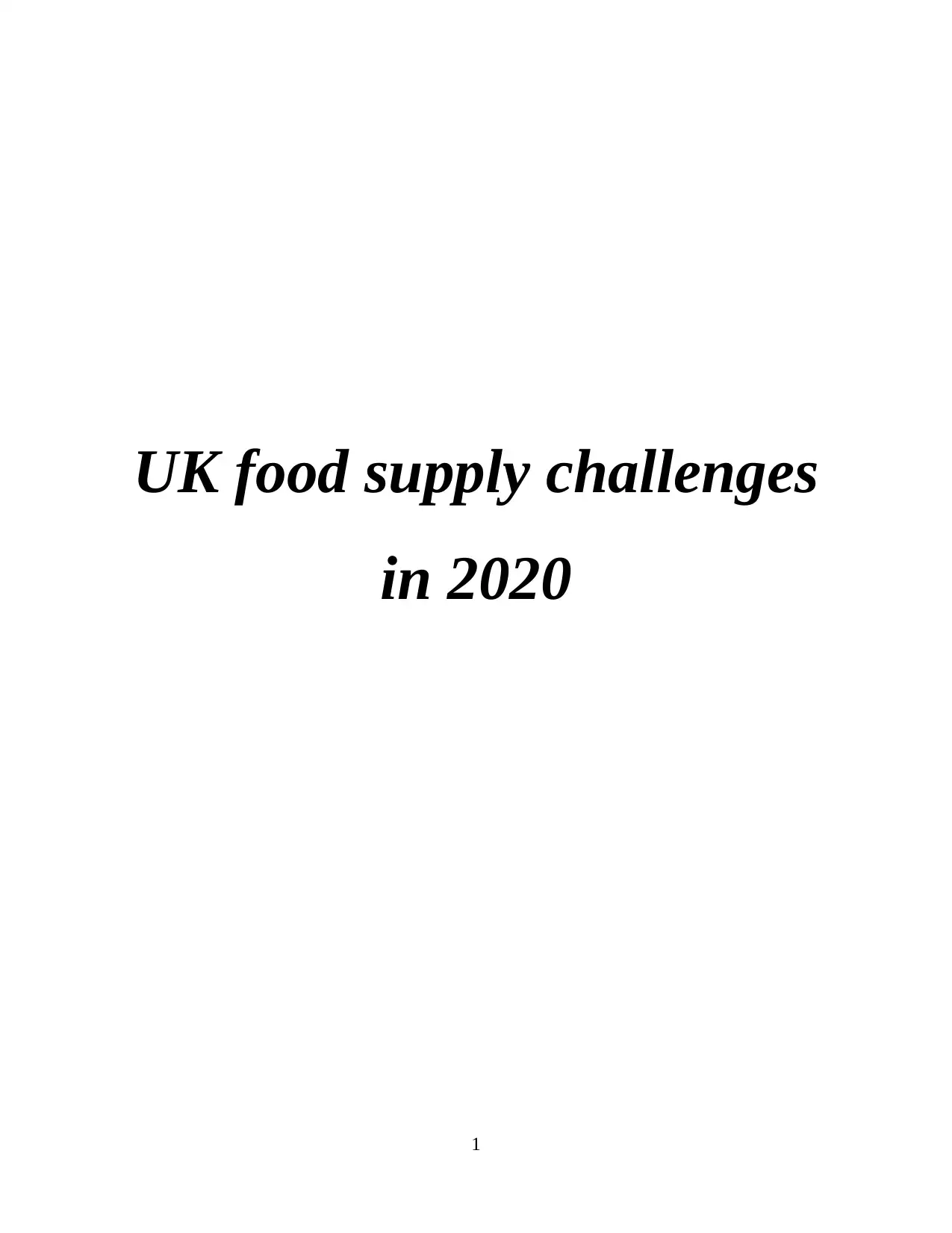
UK food supply challenges
in 2020
1
in 2020
1
Paraphrase This Document
Need a fresh take? Get an instant paraphrase of this document with our AI Paraphraser
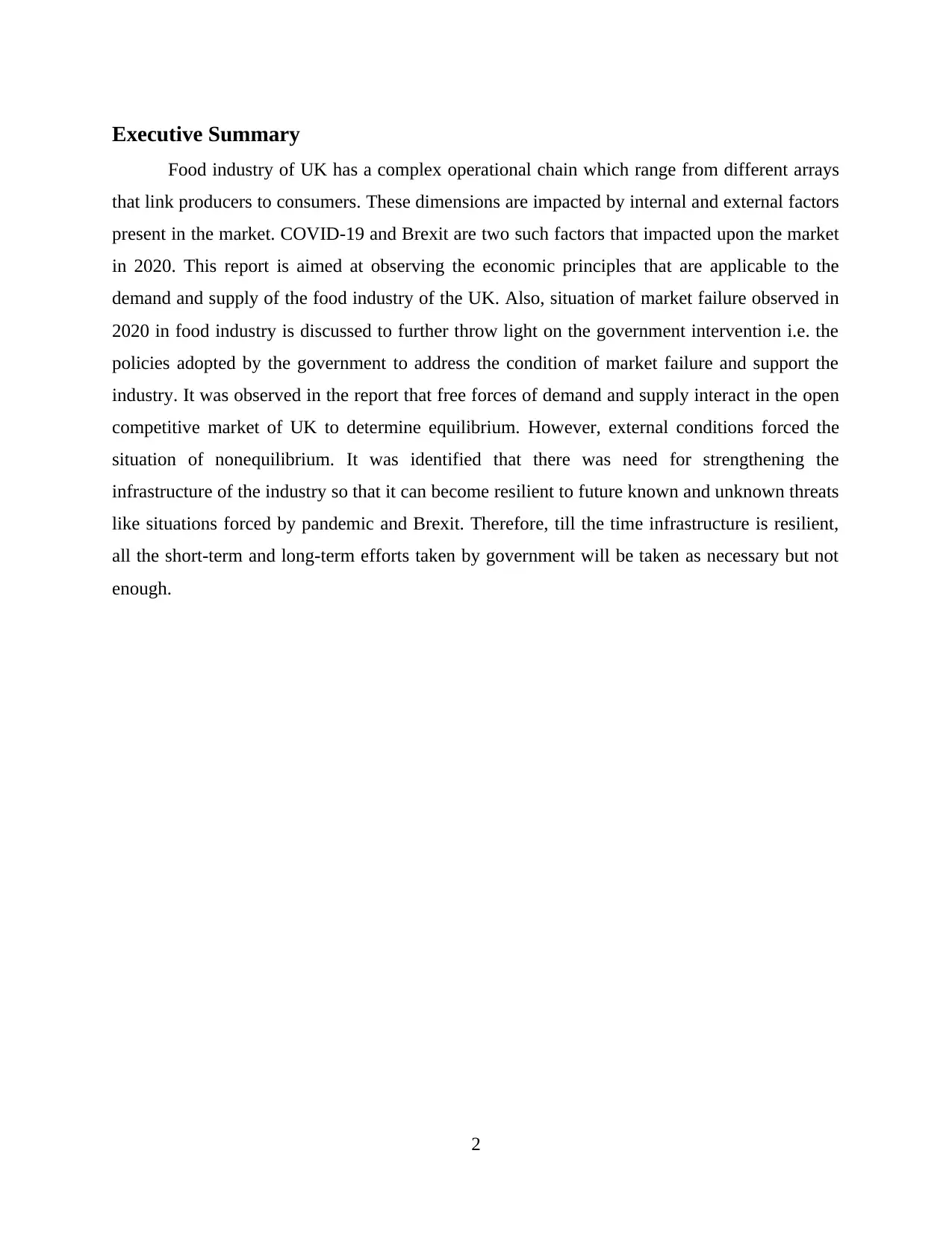
Executive Summary
Food industry of UK has a complex operational chain which range from different arrays
that link producers to consumers. These dimensions are impacted by internal and external factors
present in the market. COVID-19 and Brexit are two such factors that impacted upon the market
in 2020. This report is aimed at observing the economic principles that are applicable to the
demand and supply of the food industry of the UK. Also, situation of market failure observed in
2020 in food industry is discussed to further throw light on the government intervention i.e. the
policies adopted by the government to address the condition of market failure and support the
industry. It was observed in the report that free forces of demand and supply interact in the open
competitive market of UK to determine equilibrium. However, external conditions forced the
situation of nonequilibrium. It was identified that there was need for strengthening the
infrastructure of the industry so that it can become resilient to future known and unknown threats
like situations forced by pandemic and Brexit. Therefore, till the time infrastructure is resilient,
all the short-term and long-term efforts taken by government will be taken as necessary but not
enough.
2
Food industry of UK has a complex operational chain which range from different arrays
that link producers to consumers. These dimensions are impacted by internal and external factors
present in the market. COVID-19 and Brexit are two such factors that impacted upon the market
in 2020. This report is aimed at observing the economic principles that are applicable to the
demand and supply of the food industry of the UK. Also, situation of market failure observed in
2020 in food industry is discussed to further throw light on the government intervention i.e. the
policies adopted by the government to address the condition of market failure and support the
industry. It was observed in the report that free forces of demand and supply interact in the open
competitive market of UK to determine equilibrium. However, external conditions forced the
situation of nonequilibrium. It was identified that there was need for strengthening the
infrastructure of the industry so that it can become resilient to future known and unknown threats
like situations forced by pandemic and Brexit. Therefore, till the time infrastructure is resilient,
all the short-term and long-term efforts taken by government will be taken as necessary but not
enough.
2
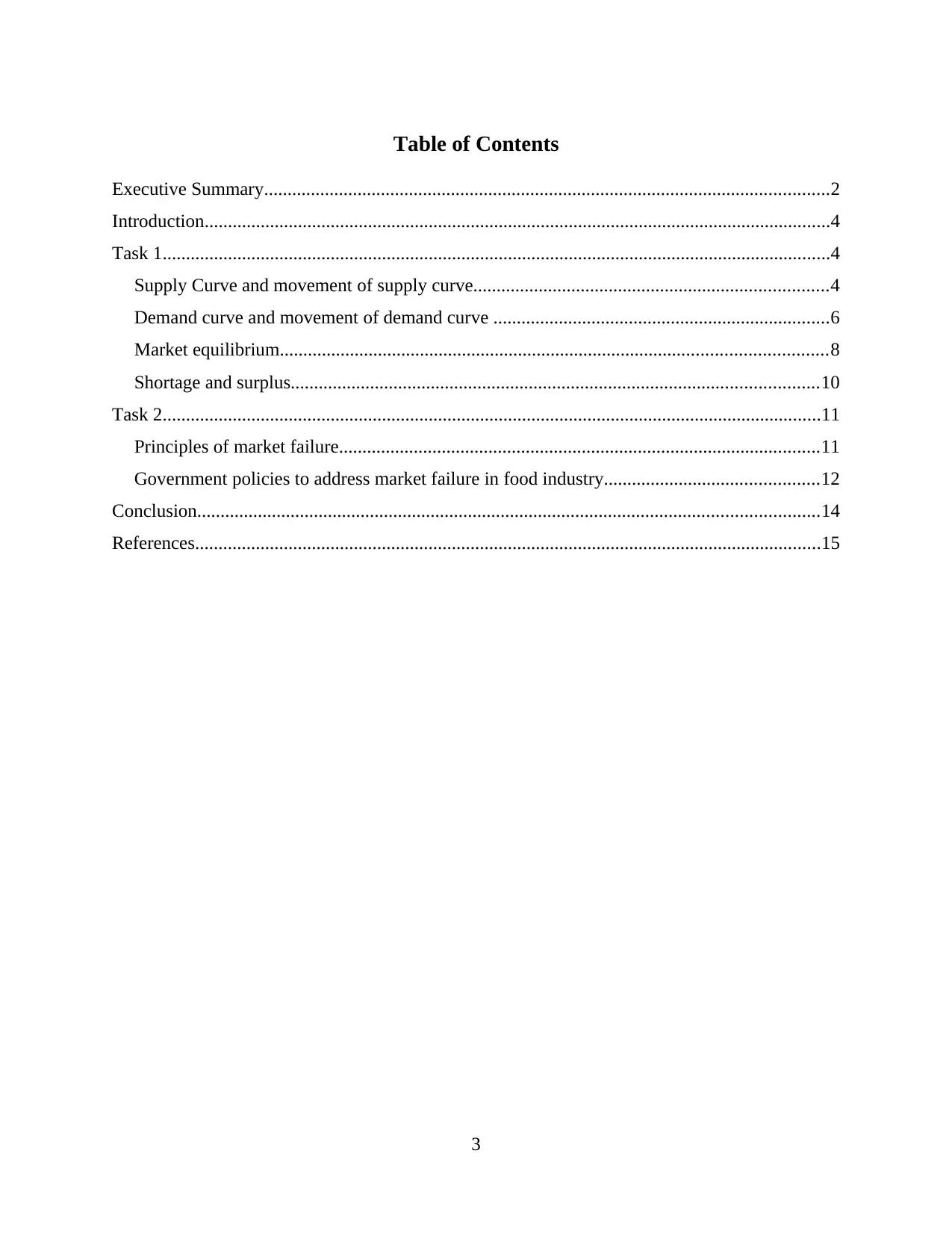
Table of Contents
Executive Summary.........................................................................................................................2
Introduction......................................................................................................................................4
Task 1...............................................................................................................................................4
Supply Curve and movement of supply curve............................................................................4
Demand curve and movement of demand curve ........................................................................6
Market equilibrium.....................................................................................................................8
Shortage and surplus.................................................................................................................10
Task 2.............................................................................................................................................11
Principles of market failure.......................................................................................................11
Government policies to address market failure in food industry..............................................12
Conclusion.....................................................................................................................................14
References......................................................................................................................................15
3
Executive Summary.........................................................................................................................2
Introduction......................................................................................................................................4
Task 1...............................................................................................................................................4
Supply Curve and movement of supply curve............................................................................4
Demand curve and movement of demand curve ........................................................................6
Market equilibrium.....................................................................................................................8
Shortage and surplus.................................................................................................................10
Task 2.............................................................................................................................................11
Principles of market failure.......................................................................................................11
Government policies to address market failure in food industry..............................................12
Conclusion.....................................................................................................................................14
References......................................................................................................................................15
3
⊘ This is a preview!⊘
Do you want full access?
Subscribe today to unlock all pages.

Trusted by 1+ million students worldwide
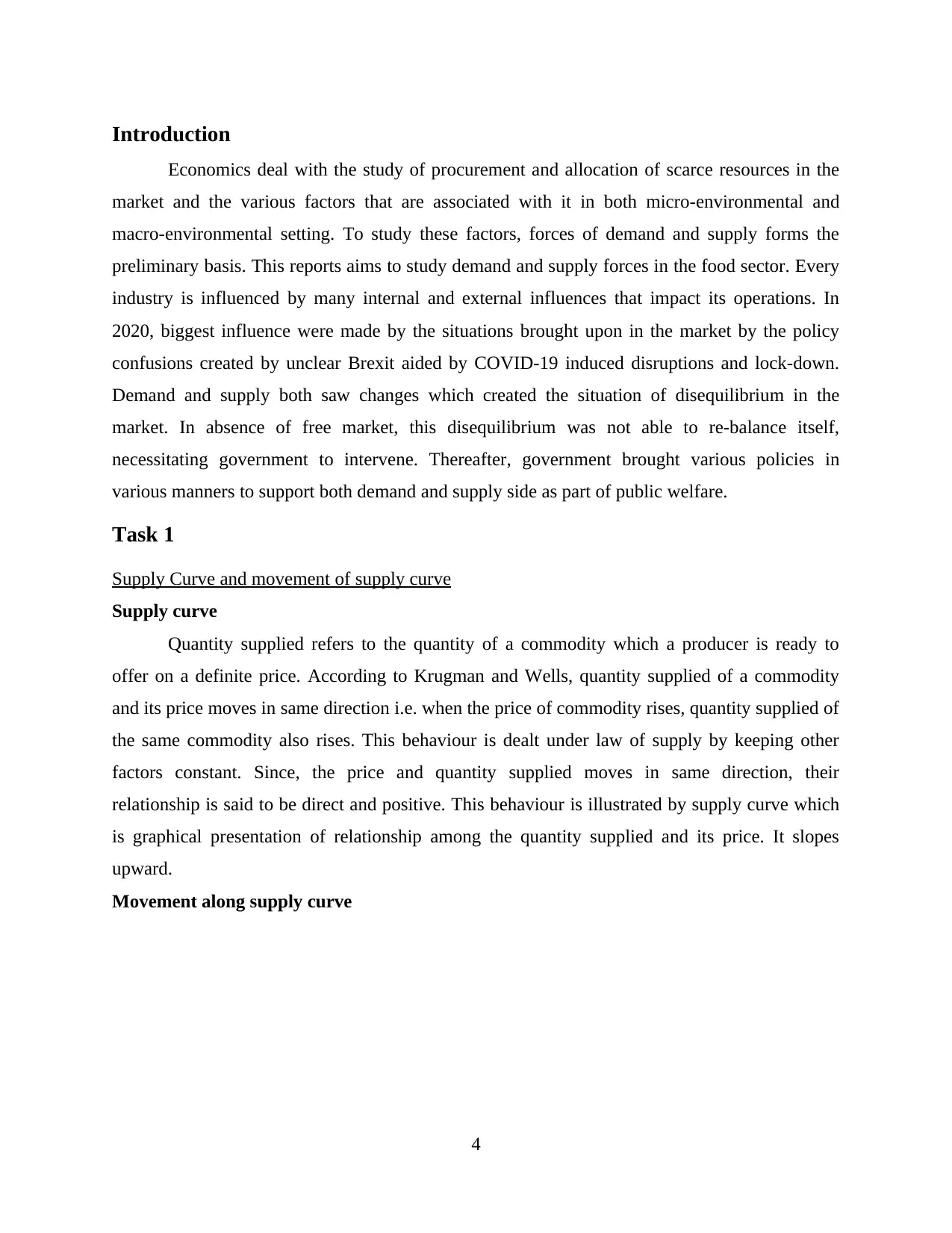
Introduction
Economics deal with the study of procurement and allocation of scarce resources in the
market and the various factors that are associated with it in both micro-environmental and
macro-environmental setting. To study these factors, forces of demand and supply forms the
preliminary basis. This reports aims to study demand and supply forces in the food sector. Every
industry is influenced by many internal and external influences that impact its operations. In
2020, biggest influence were made by the situations brought upon in the market by the policy
confusions created by unclear Brexit aided by COVID-19 induced disruptions and lock-down.
Demand and supply both saw changes which created the situation of disequilibrium in the
market. In absence of free market, this disequilibrium was not able to re-balance itself,
necessitating government to intervene. Thereafter, government brought various policies in
various manners to support both demand and supply side as part of public welfare.
Task 1
Supply Curve and movement of supply curve
Supply curve
Quantity supplied refers to the quantity of a commodity which a producer is ready to
offer on a definite price. According to Krugman and Wells, quantity supplied of a commodity
and its price moves in same direction i.e. when the price of commodity rises, quantity supplied of
the same commodity also rises. This behaviour is dealt under law of supply by keeping other
factors constant. Since, the price and quantity supplied moves in same direction, their
relationship is said to be direct and positive. This behaviour is illustrated by supply curve which
is graphical presentation of relationship among the quantity supplied and its price. It slopes
upward.
Movement along supply curve
4
Economics deal with the study of procurement and allocation of scarce resources in the
market and the various factors that are associated with it in both micro-environmental and
macro-environmental setting. To study these factors, forces of demand and supply forms the
preliminary basis. This reports aims to study demand and supply forces in the food sector. Every
industry is influenced by many internal and external influences that impact its operations. In
2020, biggest influence were made by the situations brought upon in the market by the policy
confusions created by unclear Brexit aided by COVID-19 induced disruptions and lock-down.
Demand and supply both saw changes which created the situation of disequilibrium in the
market. In absence of free market, this disequilibrium was not able to re-balance itself,
necessitating government to intervene. Thereafter, government brought various policies in
various manners to support both demand and supply side as part of public welfare.
Task 1
Supply Curve and movement of supply curve
Supply curve
Quantity supplied refers to the quantity of a commodity which a producer is ready to
offer on a definite price. According to Krugman and Wells, quantity supplied of a commodity
and its price moves in same direction i.e. when the price of commodity rises, quantity supplied of
the same commodity also rises. This behaviour is dealt under law of supply by keeping other
factors constant. Since, the price and quantity supplied moves in same direction, their
relationship is said to be direct and positive. This behaviour is illustrated by supply curve which
is graphical presentation of relationship among the quantity supplied and its price. It slopes
upward.
Movement along supply curve
4
Paraphrase This Document
Need a fresh take? Get an instant paraphrase of this document with our AI Paraphraser
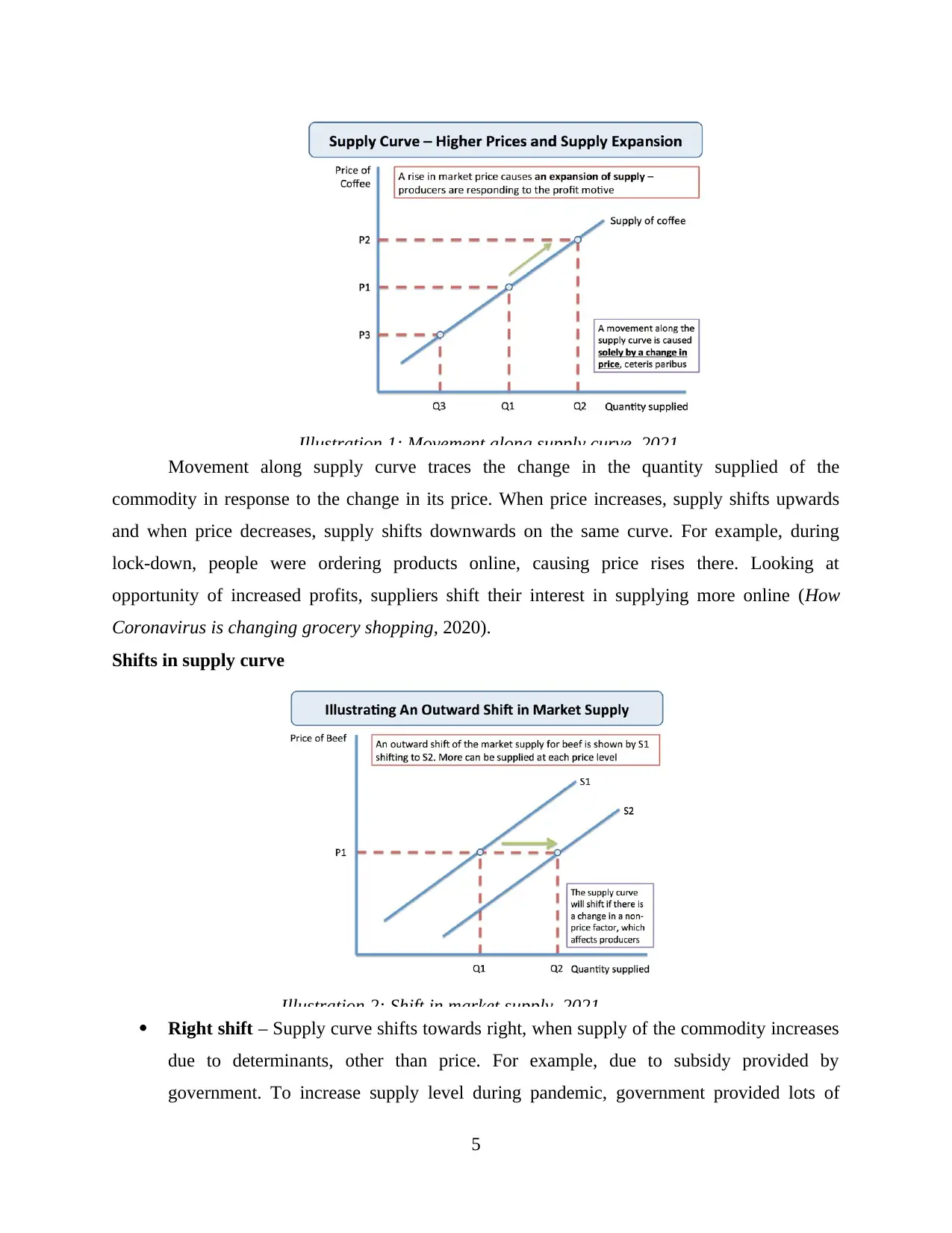
Illustration 1: Movement along supply curve, 2021
Movement along supply curve traces the change in the quantity supplied of the
commodity in response to the change in its price. When price increases, supply shifts upwards
and when price decreases, supply shifts downwards on the same curve. For example, during
lock-down, people were ordering products online, causing price rises there. Looking at
opportunity of increased profits, suppliers shift their interest in supplying more online (How
Coronavirus is changing grocery shopping, 2020).
Shifts in supply curve
Illustration 2: Shift in market supply, 2021
Right shift – Supply curve shifts towards right, when supply of the commodity increases
due to determinants, other than price. For example, due to subsidy provided by
government. To increase supply level during pandemic, government provided lots of
5
Movement along supply curve traces the change in the quantity supplied of the
commodity in response to the change in its price. When price increases, supply shifts upwards
and when price decreases, supply shifts downwards on the same curve. For example, during
lock-down, people were ordering products online, causing price rises there. Looking at
opportunity of increased profits, suppliers shift their interest in supplying more online (How
Coronavirus is changing grocery shopping, 2020).
Shifts in supply curve
Illustration 2: Shift in market supply, 2021
Right shift – Supply curve shifts towards right, when supply of the commodity increases
due to determinants, other than price. For example, due to subsidy provided by
government. To increase supply level during pandemic, government provided lots of
5
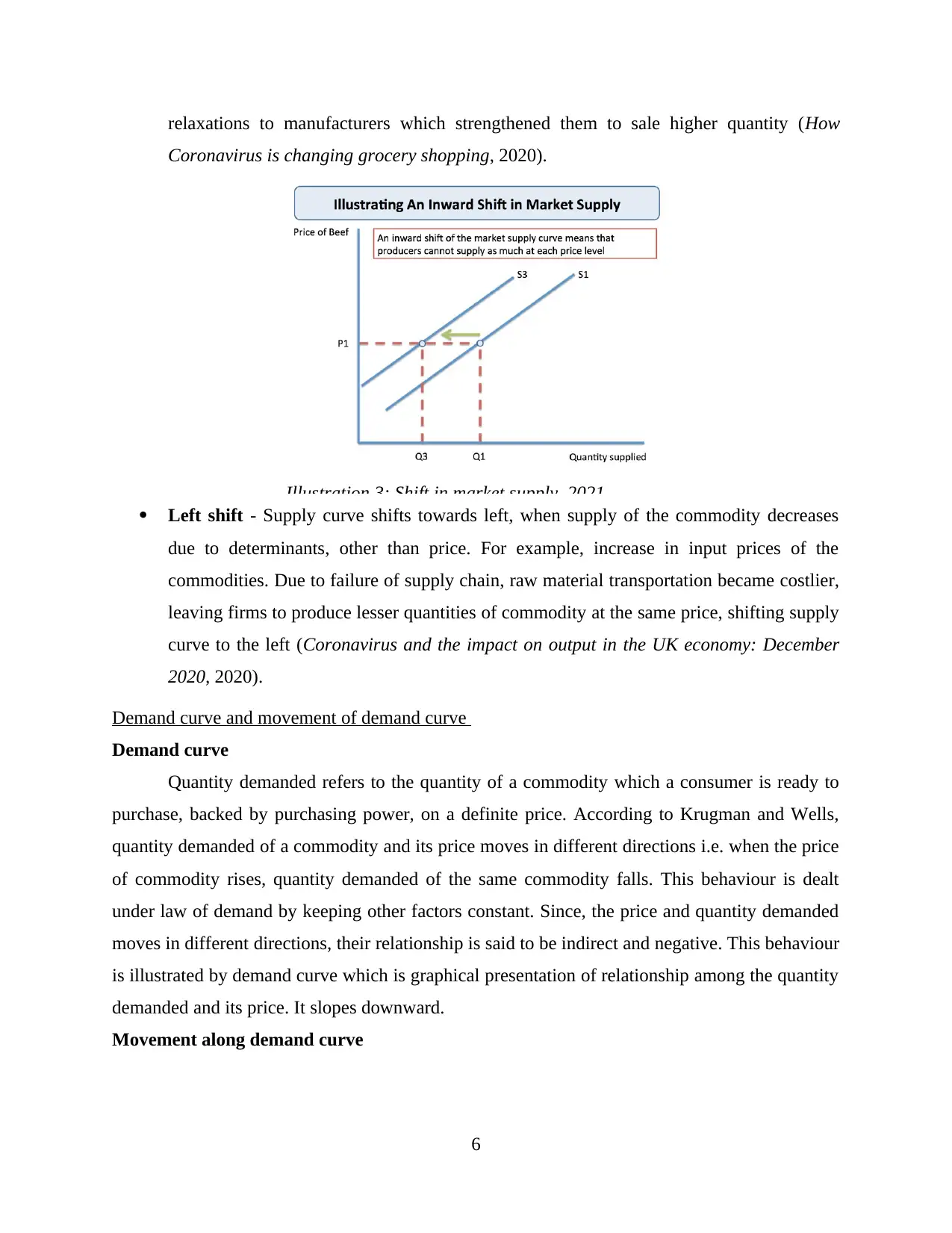
relaxations to manufacturers which strengthened them to sale higher quantity (How
Coronavirus is changing grocery shopping, 2020).
Illustration 3: Shift in market supply, 2021
Left shift - Supply curve shifts towards left, when supply of the commodity decreases
due to determinants, other than price. For example, increase in input prices of the
commodities. Due to failure of supply chain, raw material transportation became costlier,
leaving firms to produce lesser quantities of commodity at the same price, shifting supply
curve to the left (Coronavirus and the impact on output in the UK economy: December
2020, 2020).
Demand curve and movement of demand curve
Demand curve
Quantity demanded refers to the quantity of a commodity which a consumer is ready to
purchase, backed by purchasing power, on a definite price. According to Krugman and Wells,
quantity demanded of a commodity and its price moves in different directions i.e. when the price
of commodity rises, quantity demanded of the same commodity falls. This behaviour is dealt
under law of demand by keeping other factors constant. Since, the price and quantity demanded
moves in different directions, their relationship is said to be indirect and negative. This behaviour
is illustrated by demand curve which is graphical presentation of relationship among the quantity
demanded and its price. It slopes downward.
Movement along demand curve
6
Coronavirus is changing grocery shopping, 2020).
Illustration 3: Shift in market supply, 2021
Left shift - Supply curve shifts towards left, when supply of the commodity decreases
due to determinants, other than price. For example, increase in input prices of the
commodities. Due to failure of supply chain, raw material transportation became costlier,
leaving firms to produce lesser quantities of commodity at the same price, shifting supply
curve to the left (Coronavirus and the impact on output in the UK economy: December
2020, 2020).
Demand curve and movement of demand curve
Demand curve
Quantity demanded refers to the quantity of a commodity which a consumer is ready to
purchase, backed by purchasing power, on a definite price. According to Krugman and Wells,
quantity demanded of a commodity and its price moves in different directions i.e. when the price
of commodity rises, quantity demanded of the same commodity falls. This behaviour is dealt
under law of demand by keeping other factors constant. Since, the price and quantity demanded
moves in different directions, their relationship is said to be indirect and negative. This behaviour
is illustrated by demand curve which is graphical presentation of relationship among the quantity
demanded and its price. It slopes downward.
Movement along demand curve
6
⊘ This is a preview!⊘
Do you want full access?
Subscribe today to unlock all pages.

Trusted by 1+ million students worldwide
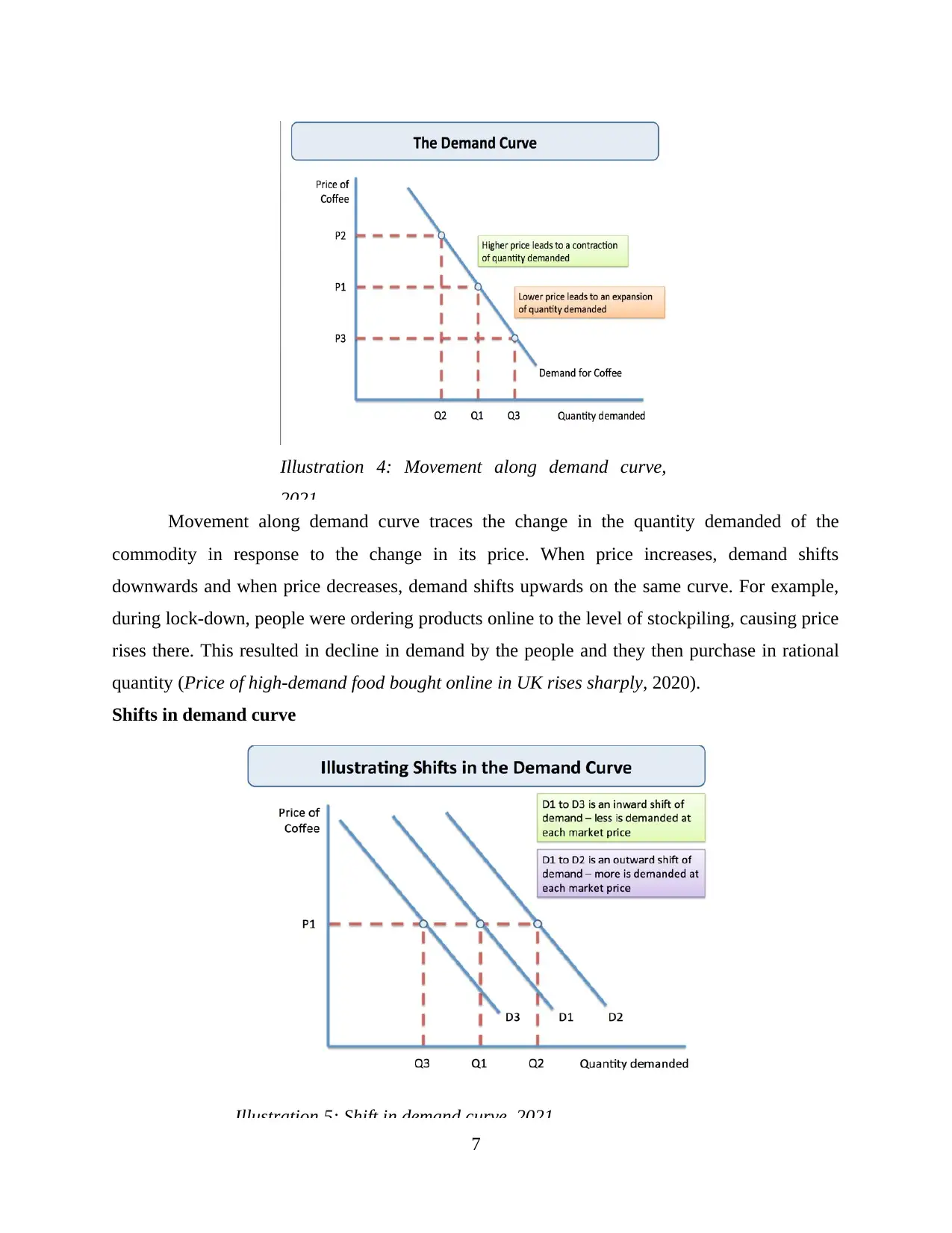
Illustration 4: Movement along demand curve,
2021
Movement along demand curve traces the change in the quantity demanded of the
commodity in response to the change in its price. When price increases, demand shifts
downwards and when price decreases, demand shifts upwards on the same curve. For example,
during lock-down, people were ordering products online to the level of stockpiling, causing price
rises there. This resulted in decline in demand by the people and they then purchase in rational
quantity (Price of high-demand food bought online in UK rises sharply, 2020).
Shifts in demand curve
Illustration 5: Shift in demand curve, 2021
7
2021
Movement along demand curve traces the change in the quantity demanded of the
commodity in response to the change in its price. When price increases, demand shifts
downwards and when price decreases, demand shifts upwards on the same curve. For example,
during lock-down, people were ordering products online to the level of stockpiling, causing price
rises there. This resulted in decline in demand by the people and they then purchase in rational
quantity (Price of high-demand food bought online in UK rises sharply, 2020).
Shifts in demand curve
Illustration 5: Shift in demand curve, 2021
7
Paraphrase This Document
Need a fresh take? Get an instant paraphrase of this document with our AI Paraphraser
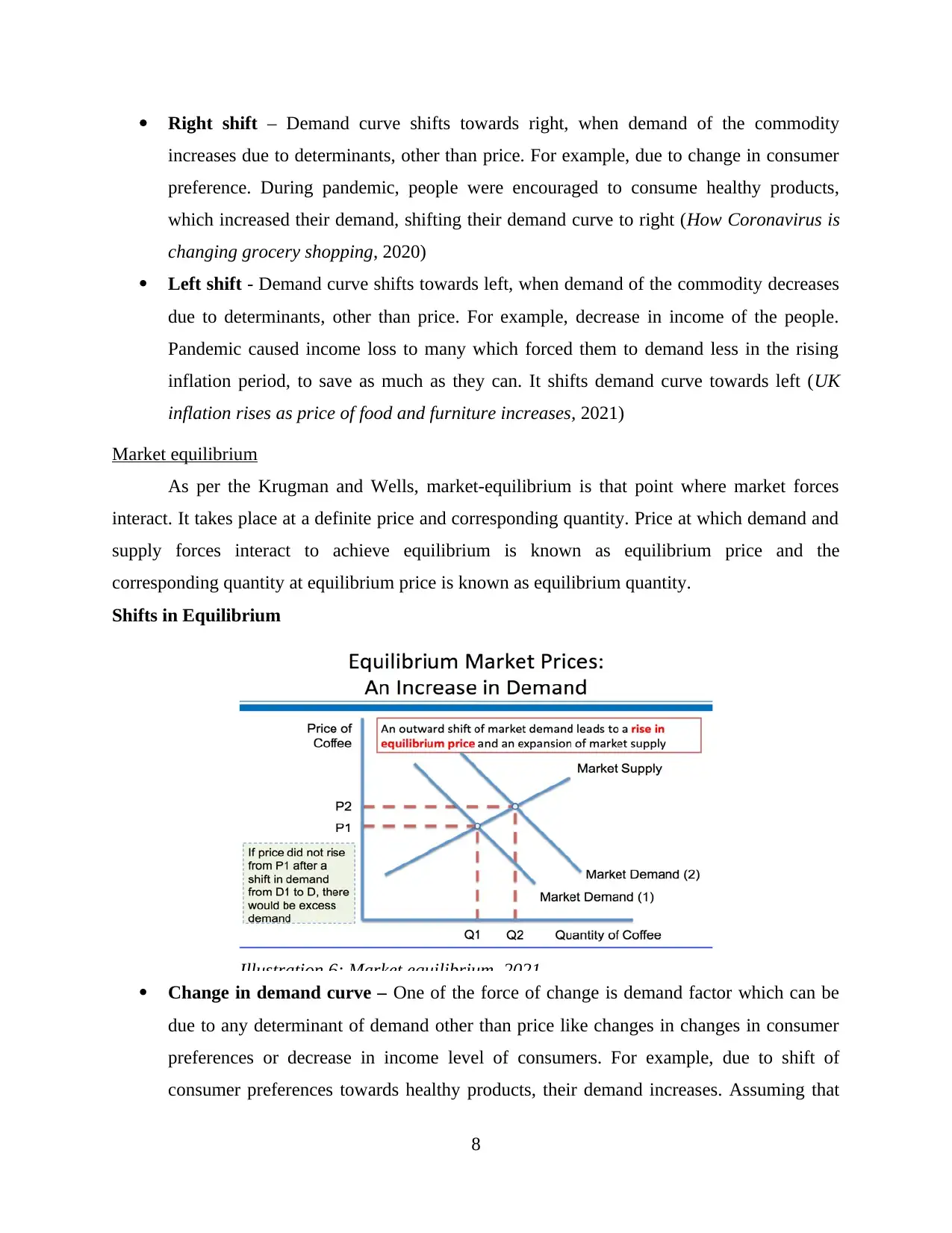
Right shift – Demand curve shifts towards right, when demand of the commodity
increases due to determinants, other than price. For example, due to change in consumer
preference. During pandemic, people were encouraged to consume healthy products,
which increased their demand, shifting their demand curve to right (How Coronavirus is
changing grocery shopping, 2020)
Left shift - Demand curve shifts towards left, when demand of the commodity decreases
due to determinants, other than price. For example, decrease in income of the people.
Pandemic caused income loss to many which forced them to demand less in the rising
inflation period, to save as much as they can. It shifts demand curve towards left (UK
inflation rises as price of food and furniture increases, 2021)
Market equilibrium
As per the Krugman and Wells, market-equilibrium is that point where market forces
interact. It takes place at a definite price and corresponding quantity. Price at which demand and
supply forces interact to achieve equilibrium is known as equilibrium price and the
corresponding quantity at equilibrium price is known as equilibrium quantity.
Shifts in Equilibrium
Illustration 6: Market equilibrium, 2021
Change in demand curve – One of the force of change is demand factor which can be
due to any determinant of demand other than price like changes in changes in consumer
preferences or decrease in income level of consumers. For example, due to shift of
consumer preferences towards healthy products, their demand increases. Assuming that
8
increases due to determinants, other than price. For example, due to change in consumer
preference. During pandemic, people were encouraged to consume healthy products,
which increased their demand, shifting their demand curve to right (How Coronavirus is
changing grocery shopping, 2020)
Left shift - Demand curve shifts towards left, when demand of the commodity decreases
due to determinants, other than price. For example, decrease in income of the people.
Pandemic caused income loss to many which forced them to demand less in the rising
inflation period, to save as much as they can. It shifts demand curve towards left (UK
inflation rises as price of food and furniture increases, 2021)
Market equilibrium
As per the Krugman and Wells, market-equilibrium is that point where market forces
interact. It takes place at a definite price and corresponding quantity. Price at which demand and
supply forces interact to achieve equilibrium is known as equilibrium price and the
corresponding quantity at equilibrium price is known as equilibrium quantity.
Shifts in Equilibrium
Illustration 6: Market equilibrium, 2021
Change in demand curve – One of the force of change is demand factor which can be
due to any determinant of demand other than price like changes in changes in consumer
preferences or decrease in income level of consumers. For example, due to shift of
consumer preferences towards healthy products, their demand increases. Assuming that
8
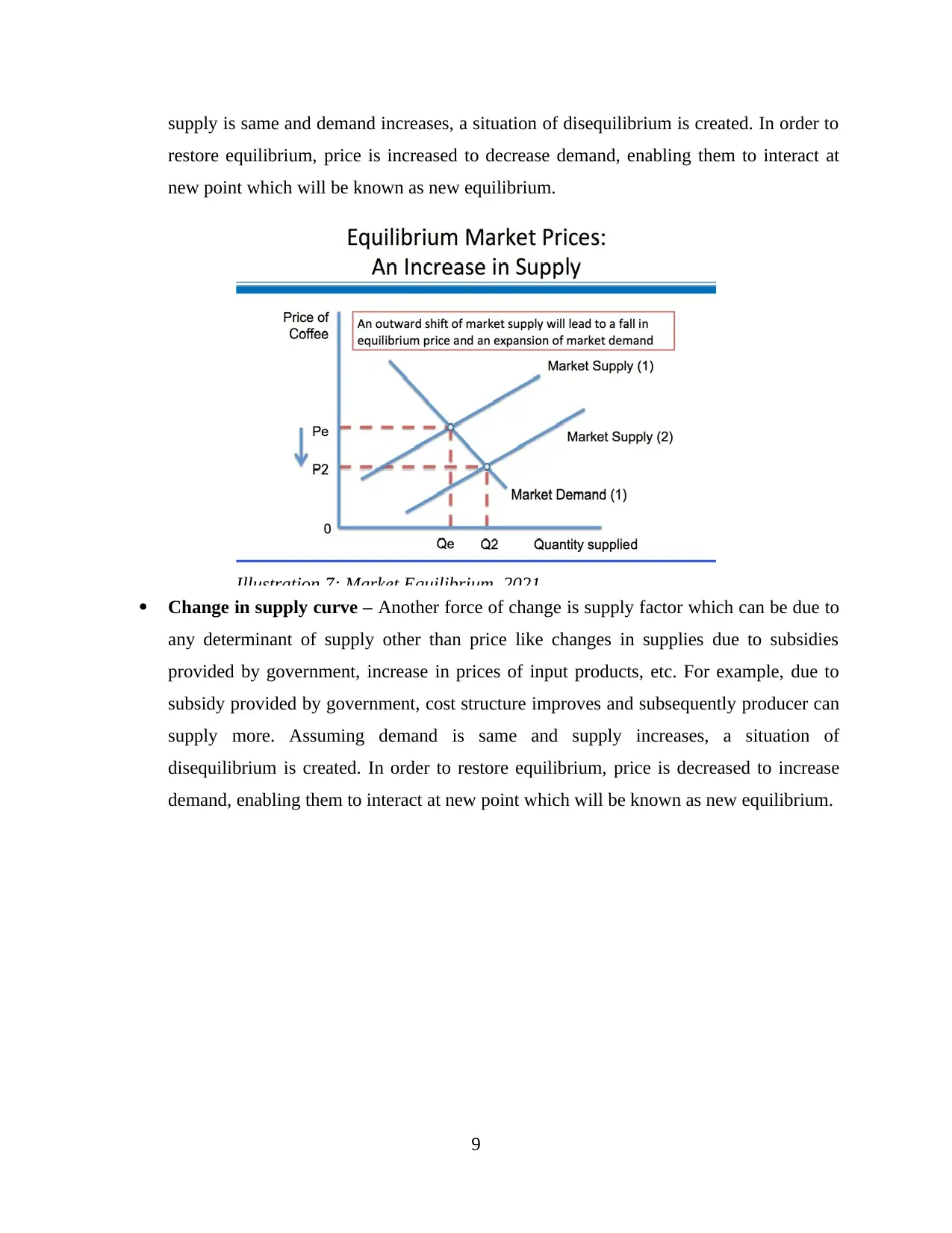
supply is same and demand increases, a situation of disequilibrium is created. In order to
restore equilibrium, price is increased to decrease demand, enabling them to interact at
new point which will be known as new equilibrium.
Illustration 7: Market Equilibrium, 2021
Change in supply curve – Another force of change is supply factor which can be due to
any determinant of supply other than price like changes in supplies due to subsidies
provided by government, increase in prices of input products, etc. For example, due to
subsidy provided by government, cost structure improves and subsequently producer can
supply more. Assuming demand is same and supply increases, a situation of
disequilibrium is created. In order to restore equilibrium, price is decreased to increase
demand, enabling them to interact at new point which will be known as new equilibrium.
9
restore equilibrium, price is increased to decrease demand, enabling them to interact at
new point which will be known as new equilibrium.
Illustration 7: Market Equilibrium, 2021
Change in supply curve – Another force of change is supply factor which can be due to
any determinant of supply other than price like changes in supplies due to subsidies
provided by government, increase in prices of input products, etc. For example, due to
subsidy provided by government, cost structure improves and subsequently producer can
supply more. Assuming demand is same and supply increases, a situation of
disequilibrium is created. In order to restore equilibrium, price is decreased to increase
demand, enabling them to interact at new point which will be known as new equilibrium.
9
⊘ This is a preview!⊘
Do you want full access?
Subscribe today to unlock all pages.

Trusted by 1+ million students worldwide
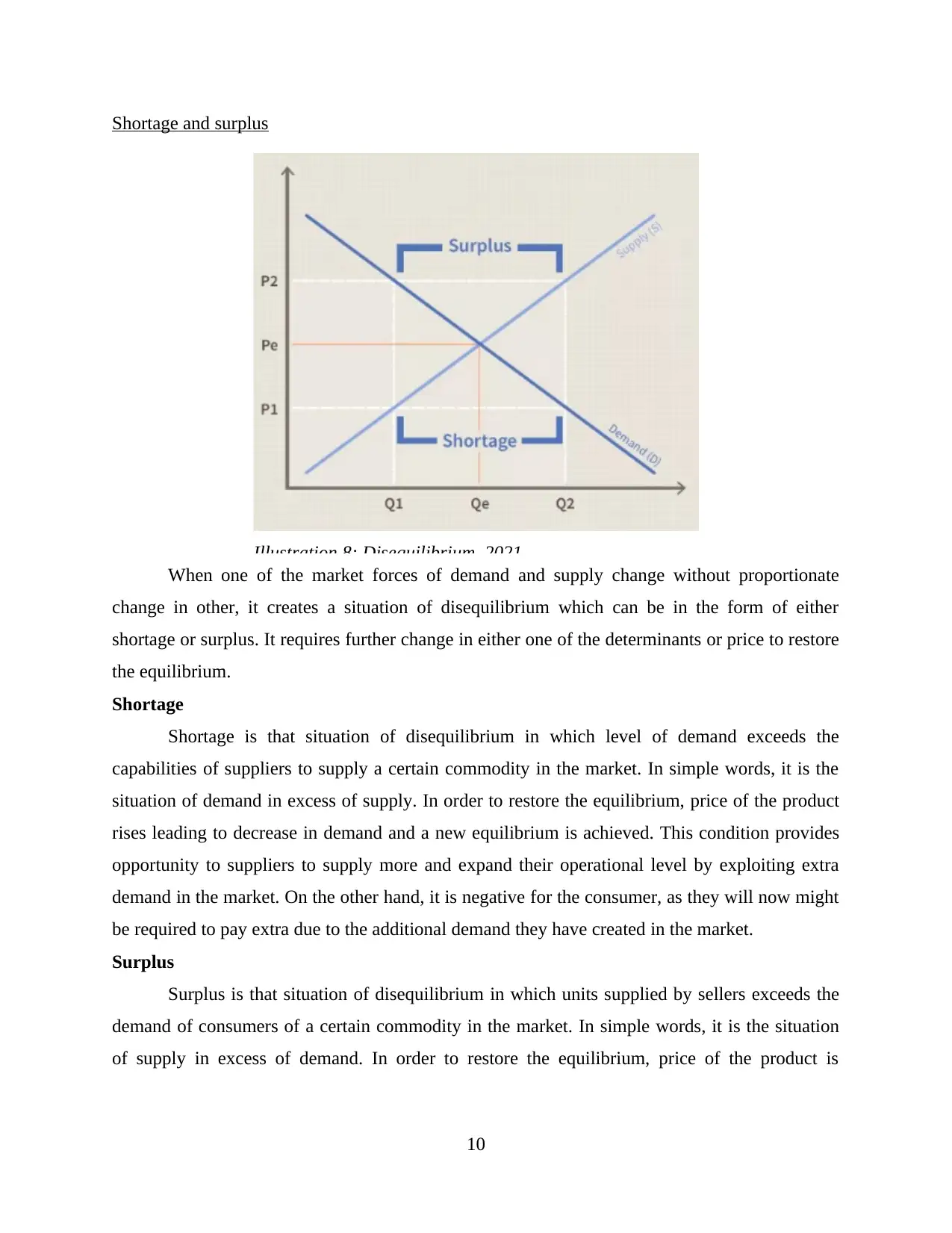
Shortage and surplus
Illustration 8: Disequilibrium, 2021
When one of the market forces of demand and supply change without proportionate
change in other, it creates a situation of disequilibrium which can be in the form of either
shortage or surplus. It requires further change in either one of the determinants or price to restore
the equilibrium.
Shortage
Shortage is that situation of disequilibrium in which level of demand exceeds the
capabilities of suppliers to supply a certain commodity in the market. In simple words, it is the
situation of demand in excess of supply. In order to restore the equilibrium, price of the product
rises leading to decrease in demand and a new equilibrium is achieved. This condition provides
opportunity to suppliers to supply more and expand their operational level by exploiting extra
demand in the market. On the other hand, it is negative for the consumer, as they will now might
be required to pay extra due to the additional demand they have created in the market.
Surplus
Surplus is that situation of disequilibrium in which units supplied by sellers exceeds the
demand of consumers of a certain commodity in the market. In simple words, it is the situation
of supply in excess of demand. In order to restore the equilibrium, price of the product is
10
Illustration 8: Disequilibrium, 2021
When one of the market forces of demand and supply change without proportionate
change in other, it creates a situation of disequilibrium which can be in the form of either
shortage or surplus. It requires further change in either one of the determinants or price to restore
the equilibrium.
Shortage
Shortage is that situation of disequilibrium in which level of demand exceeds the
capabilities of suppliers to supply a certain commodity in the market. In simple words, it is the
situation of demand in excess of supply. In order to restore the equilibrium, price of the product
rises leading to decrease in demand and a new equilibrium is achieved. This condition provides
opportunity to suppliers to supply more and expand their operational level by exploiting extra
demand in the market. On the other hand, it is negative for the consumer, as they will now might
be required to pay extra due to the additional demand they have created in the market.
Surplus
Surplus is that situation of disequilibrium in which units supplied by sellers exceeds the
demand of consumers of a certain commodity in the market. In simple words, it is the situation
of supply in excess of demand. In order to restore the equilibrium, price of the product is
10
Paraphrase This Document
Need a fresh take? Get an instant paraphrase of this document with our AI Paraphraser
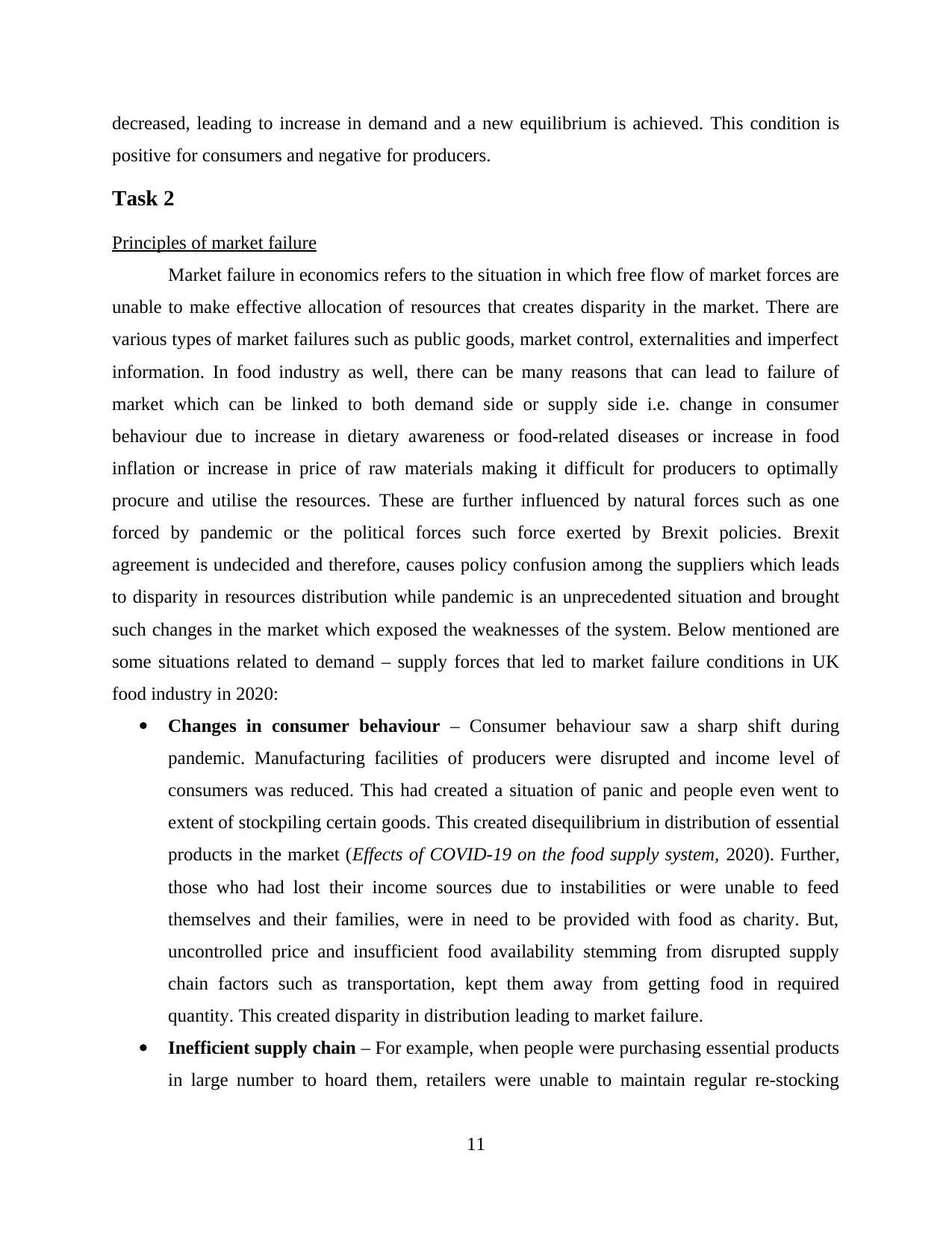
decreased, leading to increase in demand and a new equilibrium is achieved. This condition is
positive for consumers and negative for producers.
Task 2
Principles of market failure
Market failure in economics refers to the situation in which free flow of market forces are
unable to make effective allocation of resources that creates disparity in the market. There are
various types of market failures such as public goods, market control, externalities and imperfect
information. In food industry as well, there can be many reasons that can lead to failure of
market which can be linked to both demand side or supply side i.e. change in consumer
behaviour due to increase in dietary awareness or food-related diseases or increase in food
inflation or increase in price of raw materials making it difficult for producers to optimally
procure and utilise the resources. These are further influenced by natural forces such as one
forced by pandemic or the political forces such force exerted by Brexit policies. Brexit
agreement is undecided and therefore, causes policy confusion among the suppliers which leads
to disparity in resources distribution while pandemic is an unprecedented situation and brought
such changes in the market which exposed the weaknesses of the system. Below mentioned are
some situations related to demand – supply forces that led to market failure conditions in UK
food industry in 2020:
Changes in consumer behaviour – Consumer behaviour saw a sharp shift during
pandemic. Manufacturing facilities of producers were disrupted and income level of
consumers was reduced. This had created a situation of panic and people even went to
extent of stockpiling certain goods. This created disequilibrium in distribution of essential
products in the market (Effects of COVID-19 on the food supply system, 2020). Further,
those who had lost their income sources due to instabilities or were unable to feed
themselves and their families, were in need to be provided with food as charity. But,
uncontrolled price and insufficient food availability stemming from disrupted supply
chain factors such as transportation, kept them away from getting food in required
quantity. This created disparity in distribution leading to market failure.
Inefficient supply chain – For example, when people were purchasing essential products
in large number to hoard them, retailers were unable to maintain regular re-stocking
11
positive for consumers and negative for producers.
Task 2
Principles of market failure
Market failure in economics refers to the situation in which free flow of market forces are
unable to make effective allocation of resources that creates disparity in the market. There are
various types of market failures such as public goods, market control, externalities and imperfect
information. In food industry as well, there can be many reasons that can lead to failure of
market which can be linked to both demand side or supply side i.e. change in consumer
behaviour due to increase in dietary awareness or food-related diseases or increase in food
inflation or increase in price of raw materials making it difficult for producers to optimally
procure and utilise the resources. These are further influenced by natural forces such as one
forced by pandemic or the political forces such force exerted by Brexit policies. Brexit
agreement is undecided and therefore, causes policy confusion among the suppliers which leads
to disparity in resources distribution while pandemic is an unprecedented situation and brought
such changes in the market which exposed the weaknesses of the system. Below mentioned are
some situations related to demand – supply forces that led to market failure conditions in UK
food industry in 2020:
Changes in consumer behaviour – Consumer behaviour saw a sharp shift during
pandemic. Manufacturing facilities of producers were disrupted and income level of
consumers was reduced. This had created a situation of panic and people even went to
extent of stockpiling certain goods. This created disequilibrium in distribution of essential
products in the market (Effects of COVID-19 on the food supply system, 2020). Further,
those who had lost their income sources due to instabilities or were unable to feed
themselves and their families, were in need to be provided with food as charity. But,
uncontrolled price and insufficient food availability stemming from disrupted supply
chain factors such as transportation, kept them away from getting food in required
quantity. This created disparity in distribution leading to market failure.
Inefficient supply chain – For example, when people were purchasing essential products
in large number to hoard them, retailers were unable to maintain regular re-stocking
11
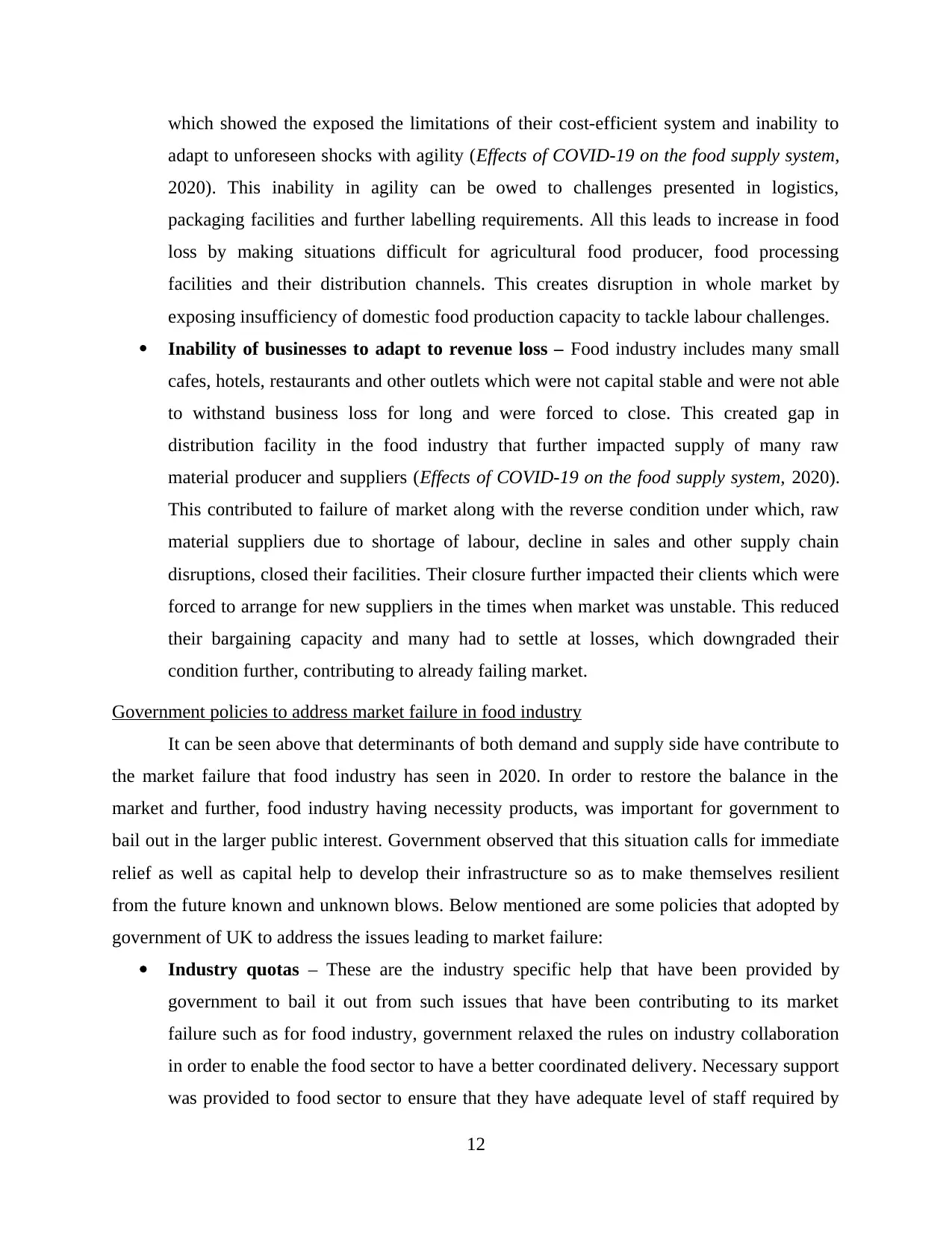
which showed the exposed the limitations of their cost-efficient system and inability to
adapt to unforeseen shocks with agility (Effects of COVID-19 on the food supply system,
2020). This inability in agility can be owed to challenges presented in logistics,
packaging facilities and further labelling requirements. All this leads to increase in food
loss by making situations difficult for agricultural food producer, food processing
facilities and their distribution channels. This creates disruption in whole market by
exposing insufficiency of domestic food production capacity to tackle labour challenges.
Inability of businesses to adapt to revenue loss – Food industry includes many small
cafes, hotels, restaurants and other outlets which were not capital stable and were not able
to withstand business loss for long and were forced to close. This created gap in
distribution facility in the food industry that further impacted supply of many raw
material producer and suppliers (Effects of COVID-19 on the food supply system, 2020).
This contributed to failure of market along with the reverse condition under which, raw
material suppliers due to shortage of labour, decline in sales and other supply chain
disruptions, closed their facilities. Their closure further impacted their clients which were
forced to arrange for new suppliers in the times when market was unstable. This reduced
their bargaining capacity and many had to settle at losses, which downgraded their
condition further, contributing to already failing market.
Government policies to address market failure in food industry
It can be seen above that determinants of both demand and supply side have contribute to
the market failure that food industry has seen in 2020. In order to restore the balance in the
market and further, food industry having necessity products, was important for government to
bail out in the larger public interest. Government observed that this situation calls for immediate
relief as well as capital help to develop their infrastructure so as to make themselves resilient
from the future known and unknown blows. Below mentioned are some policies that adopted by
government of UK to address the issues leading to market failure:
Industry quotas – These are the industry specific help that have been provided by
government to bail it out from such issues that have been contributing to its market
failure such as for food industry, government relaxed the rules on industry collaboration
in order to enable the food sector to have a better coordinated delivery. Necessary support
was provided to food sector to ensure that they have adequate level of staff required by
12
adapt to unforeseen shocks with agility (Effects of COVID-19 on the food supply system,
2020). This inability in agility can be owed to challenges presented in logistics,
packaging facilities and further labelling requirements. All this leads to increase in food
loss by making situations difficult for agricultural food producer, food processing
facilities and their distribution channels. This creates disruption in whole market by
exposing insufficiency of domestic food production capacity to tackle labour challenges.
Inability of businesses to adapt to revenue loss – Food industry includes many small
cafes, hotels, restaurants and other outlets which were not capital stable and were not able
to withstand business loss for long and were forced to close. This created gap in
distribution facility in the food industry that further impacted supply of many raw
material producer and suppliers (Effects of COVID-19 on the food supply system, 2020).
This contributed to failure of market along with the reverse condition under which, raw
material suppliers due to shortage of labour, decline in sales and other supply chain
disruptions, closed their facilities. Their closure further impacted their clients which were
forced to arrange for new suppliers in the times when market was unstable. This reduced
their bargaining capacity and many had to settle at losses, which downgraded their
condition further, contributing to already failing market.
Government policies to address market failure in food industry
It can be seen above that determinants of both demand and supply side have contribute to
the market failure that food industry has seen in 2020. In order to restore the balance in the
market and further, food industry having necessity products, was important for government to
bail out in the larger public interest. Government observed that this situation calls for immediate
relief as well as capital help to develop their infrastructure so as to make themselves resilient
from the future known and unknown blows. Below mentioned are some policies that adopted by
government of UK to address the issues leading to market failure:
Industry quotas – These are the industry specific help that have been provided by
government to bail it out from such issues that have been contributing to its market
failure such as for food industry, government relaxed the rules on industry collaboration
in order to enable the food sector to have a better coordinated delivery. Necessary support
was provided to food sector to ensure that they have adequate level of staff required by
12
⊘ This is a preview!⊘
Do you want full access?
Subscribe today to unlock all pages.

Trusted by 1+ million students worldwide
1 out of 15
Related Documents
Your All-in-One AI-Powered Toolkit for Academic Success.
+13062052269
info@desklib.com
Available 24*7 on WhatsApp / Email
![[object Object]](/_next/static/media/star-bottom.7253800d.svg)
Unlock your academic potential
Copyright © 2020–2025 A2Z Services. All Rights Reserved. Developed and managed by ZUCOL.





